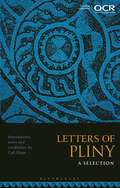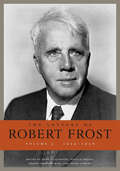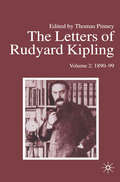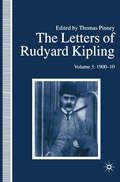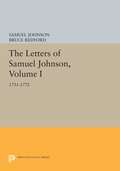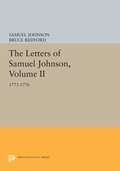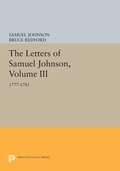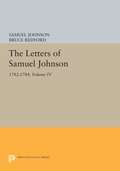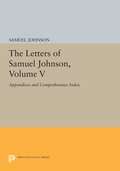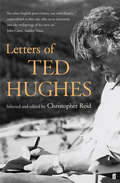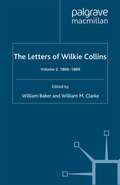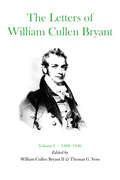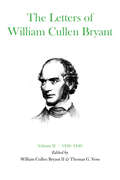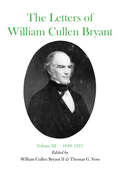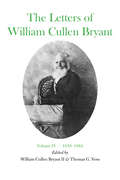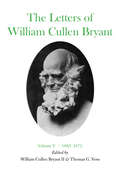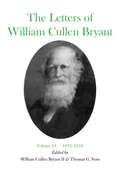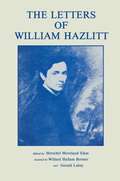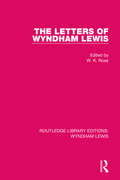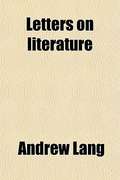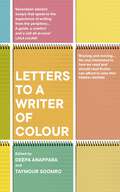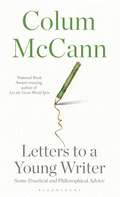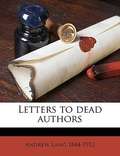- Table View
- List View
Letters of Pliny: A Selection
by Carl HopeThis is the OCR-endorsed edition covering the Latin A-Level (Group 2) prescription of Pliny, Letters 1.9; 3.16; 4.2; 4.19; 8.8; 8.16; 8.17; 9.6, giving full Latin text, commentary and vocabulary, with a detailed introduction that also covers the prescribed material to be read in English.The letters of Pliny the Younger provide a glimpse of what life at the start of the 2nd century AD was like for a member of the Roman elite, offering some insight into his roles and responsibilities, his daily concerns, and relationships both personal and professional. This wide-ranging selection includes letters of advice and praise, meditations on death and slavery, descriptions of nature or natural phenomena, and even disapproval of the Roman public's obsession with chariot-racing. Pliny shows various sides to his character and demonstrates his skill in writing, carefully constructing the persona he wants to project to posterity.Supporting resources are available on the Companion Website: https://www.bloomsbury.pub/OCR-editions-2024-2026
Letters of Pliny: A Selection
by Carl HopeThis is the OCR-endorsed edition covering the Latin A-Level (Group 2) prescription of Pliny, Letters 1.9; 3.16; 4.2; 4.19; 8.8; 8.16; 8.17; 9.6, giving full Latin text, commentary and vocabulary, with a detailed introduction that also covers the prescribed material to be read in English.The letters of Pliny the Younger provide a glimpse of what life at the start of the 2nd century AD was like for a member of the Roman elite, offering some insight into his roles and responsibilities, his daily concerns, and relationships both personal and professional. This wide-ranging selection includes letters of advice and praise, meditations on death and slavery, descriptions of nature or natural phenomena, and even disapproval of the Roman public's obsession with chariot-racing. Pliny shows various sides to his character and demonstrates his skill in writing, carefully constructing the persona he wants to project to posterity.Supporting resources are available on the Companion Website: https://www.bloomsbury.pub/OCR-editions-2024-2026
The Letters of Robert Frost, Volume 3: 1929-1936
by Robert FrostThe third installment of Harvard’s five-volume edition of Robert Frost’s correspondence. The Letters of Robert Frost, Volume 3: 1929–1936 is the latest installment in Harvard’s five-volume edition of the poet’s correspondence. It presents 589 letters, of which 424 are previously uncollected. The critically acclaimed first volume, a Times Literary Supplement Book of the Year, included nearly 300 previously uncollected letters, and the second volume 350 more. During the period covered here, Robert Frost was close to the height of his powers. If Volume 2 covered the making of Frost as America’s poet, in Volume 3 he is definitively made. These were also, however, years of personal tribulation. The once-tight Frost family broke up as marriage, illness, and work scattered the children across the country. In the case of Frost’s son Carol, both distance and proximity put strains on an already fractious relationship. But the tragedy and emotional crux of this volume is the death, in Montana, of Frost’s youngest daughter, Marjorie. Frost’s correspondence from those dark days is a powerful testament to the difficulty of honoring the responsibilities of a poet’s eminence while coping with the intensity of a parent’s grief. Volume 3 also sees Frost responding to the crisis of the Great Depression, the onset of the New Deal, and the emergence of totalitarian regimes in Europe, with wit, canny political intelligence, and no little acerbity. All the while, his star continues to rise: he wins a Pulitzer for Collected Poems in 1931 and will win a second for A Further Range, published in 1936, and he is in constant demand as a public speaker at colleges, writers’ workshops, symposia, and dinners. Frost was not just a poet but a poet-teacher; as such, he was instrumental in defining the public functions of poetry in the twentieth century. In the 1930s, Frost lived a life of paradox, as personal tragedy and the tumults of politics interwove with his unprecedented achievements. Thoroughly annotated and accompanied by a biographical glossary and detailed chronology, these letters illuminate a triumphant and difficult period in the life of a towering literary figure.
The Letters of Rudyard Kipling: Volume 2: 1890-99
by R. KiplingKipling's letters, never before collected and edited and largely unpublished, are now presented in an annotated edition based on the more than 6,000 letters preserved in public and private collections all over the world. Planned in an edition of four volumes, the Letters reveal Kipling with a fullness and immediacy of detail unmatched by any other source. The first two volumes present the first half of Kipling's life, down to the end of the nineteenth century. They show the remarkable transformation of the young schoolboy into the seasoned Indian journalist, and the even more remarkable transformation of the Indian journalist into the famous writer, the most dazzling literary success of the 1890s. Kipling's hard years of apprenticeship, his restless travels and eager encounters with cities and men, his triumphant struggles in the literary wars, are all vividly set forth. The Letters also take Kipling through his marriage and the births of his children, through the mingled happiness and distress of his American years, to the tragedy of his daughter's death at the very highest moment of his literary fame.
The Letters of Rudyard Kipling: Volume 3: 1900-10
by Thomas Pinney'The letters bring the man marvellously alive...a perfect bedside book and an important contribution to Kipling scholarship.' - Ian McIntyre, Times Volume 3 of Kipling's Letters covers the decade 1900-10, the years in which Kipling published Kim, Just So Stories, The Five Nations, Traffics and Discoveries, Puck of Pook's Hill, Actions and Reactions, and Rewards and Fairies. The narrative of his life includes the years in South Africa during and after the Boer War, his move to Bateman's in Sussex, his increasing involvement in the politics of preparedness and the growing record of his honours, culminating in the Nobel Prize.
The Letters of Samuel Johnson, Volume I: 1731-1772
by Samuel Johnson Bruce Redford"It is now become so much the fashion to publish letters, that in order to avoid it, I put as little into mine as I can," Samuel Johnson declared, according to Boswell. And Boswell answered, "Do what you will, Sir, you cannot avoid it. Should you even write as ill as you can, your letters would be published as curiosities." But Johnson's letters are far more than that. Even at their most cursory and casual, they are never less than precious biographical documents, and many of them mirror, define, and re-create a vivid likeness of the most versatile writer of eighteenth-century England. With these three volumes Princeton University Press inaugurates the first scholarly edition of this remarkable material to appear in forty years--the planned five-volume series The Letters of Samuel Johnson. Known as the Hyde Edition, the project will be completed with the fourth volume, covering the years 1782 through 1784, and the fifth, containing the comprehensive index and appendices. The series as a whole will present fifty-two previously unknown letters or parts of letters that have come to light since the publication of R. W. Chapman's three-volume set (Oxford, 1952). Such "new" letters, however, are scarcely more important than those for which only inferior printed texts or copies of varying reliability had previously been recovered. The Hyde Edition offers scores of texts transcribed for the first time from the original documents--a feature of special importance in the case of Johnson's revealing letters to Hester Thrale, many of which have been available only in expurgated form. The Hyde Edition is also the first systematically to record substantive deletions, which can yield intimate knowledge of Johnson's stylistic procedures, mental habits, and chains of association. Furthermore, its ownership credits document the current disposition of the manuscripts, hundreds of which have changed hands during the last four decades. Finally, the annotation of the letters incorporates the many significant discoveries of postwar Johnsonian scholarship, as well as decoding references that had previously resisted explanation. The result is a far richer understanding of Samuel Johnson's life, work, and milieu.Originally published in 1992.The Princeton Legacy Library uses the latest print-on-demand technology to again make available previously out-of-print books from the distinguished backlist of Princeton University Press. These editions preserve the original texts of these important books while presenting them in durable paperback and hardcover editions. The goal of the Princeton Legacy Library is to vastly increase access to the rich scholarly heritage found in the thousands of books published by Princeton University Press since its founding in 1905.
The Letters of Samuel Johnson, Volume II: 1773-1776
by Samuel Johnson Bruce RedfordThe Hyde Edition offers scores of texts transcribed for the first time from the original documents a feature of special importance in the case of Johnson's revealing letters to Hester Thrale, many of which have been available only in expurgated form. The Hyde Edition is also the first systematically to record substantive deletions, which can yield intimate knowledge of Johnson's stylistic procedures, mental habits, and chains of association. Furthermore, its ownership credits document the current disposition of the manuscripts, hundreds of which have changed hands during the last four decades. Finally, the annotation of the letters incorporates the many significant discoveries of postwar Johnsonian scholarship, as well as decoding references that had previously resisted explanation. The result is a far richer understanding of Samuel Johnson's life, work, and milieu.Originally published in 1992.The Princeton Legacy Library uses the latest print-on-demand technology to again make available previously out-of-print books from the distinguished backlist of Princeton University Press. These editions preserve the original texts of these important books while presenting them in durable paperback and hardcover editions. The goal of the Princeton Legacy Library is to vastly increase access to the rich scholarly heritage found in the thousands of books published by Princeton University Press since its founding in 1905.
The Letters of Samuel Johnson, Volume III: 1777-1781
by Samuel Johnson Bruce RedfordThe Hyde Edition offers scores of texts transcribed for the first time from the original documents a feature of special importance in the case of Johnson's revealing letters to Hester Thrale, many of which have been available only in expurgated form. The Hyde Edition is also the first systematically to record substantive deletions, which can yield intimate knowledge of Johnson's stylistic procedures, mental habits, and chains of association. Furthermore, its ownership credits document the current disposition of the manuscripts, hundreds of which have changed hands during the last four decades. Finally, the annotation of the letters incorporates the many significant discoveries of postwar Johnsonian scholarship, as well as decoding references that had previously resisted explanation. The result is a far richer understanding of Samuel Johnson's life, work, and milieu.Originally published in 1992.The Princeton Legacy Library uses the latest print-on-demand technology to again make available previously out-of-print books from the distinguished backlist of Princeton University Press. These editions preserve the original texts of these important books while presenting them in durable paperback and hardcover editions. The goal of the Princeton Legacy Library is to vastly increase access to the rich scholarly heritage found in the thousands of books published by Princeton University Press since its founding in 1905.
The Letters of Samuel Johnson, Volume IV: 1782-1784
by Samuel Johnson Bruce RedfordWith these two volumes Princeton University Press concludes the first scholarly edition of the letters of Samuel Johnson to appear in forty years. Volume IV chronicles the last three years of Johnson's life, an epistolary endgame that includes the breakup of the friendship with Hester Thrale and a poignant reaching out to new friends and new experiences. Volume V includes not only the comprehensive index but those undated letters that cannot confidently be assigned to a specific year, "ghost" letters (those whose existence is documented in other sources), three letters that have recently been recovered, and translations of Johnson's letters in Latin.Originally published in 1994.The Princeton Legacy Library uses the latest print-on-demand technology to again make available previously out-of-print books from the distinguished backlist of Princeton University Press. These editions preserve the original texts of these important books while presenting them in durable paperback and hardcover editions. The goal of the Princeton Legacy Library is to vastly increase access to the rich scholarly heritage found in the thousands of books published by Princeton University Press since its founding in 1905.
The Letters of Samuel Johnson, Volume V: Appendices and Comprehensive Index
by Samuel Johnson Bruce RedfordWith these two volumes Princeton University Press concludes the first scholarly edition of the letters of Samuel Johnson to appear in forty years. Volume IV chronicles the last three years of Johnson's life, an epistolary endgame that includes the breakup of the friendship with Hester Thrale and a poignant reaching out to new friends and new experiences. Volume V includes not only the comprehensive index but those undated letters that cannot confidently be assigned to a specific year, "ghost" letters (those whose existence is documented in other sources), three letters that have recently been recovered, and translations of Johnson's letters in Latin. Bruce Redford is Professor of English at the University of Chicago and the author of The Converse of the Pen: Acts of Intimacy in the Eighteenth-Century Familiar Letter (Chicago).Originally published in 1994.The Princeton Legacy Library uses the latest print-on-demand technology to again make available previously out-of-print books from the distinguished backlist of Princeton University Press. These editions preserve the original texts of these important books while presenting them in durable paperback and hardcover editions. The goal of the Princeton Legacy Library is to vastly increase access to the rich scholarly heritage found in the thousands of books published by Princeton University Press since its founding in 1905.
Letters of Ted Hughes
by Ted HughesAt the outset of his career Ted Hughes described letter writing as 'excellent training for conversation with the world', and he was to become a prolific master of this art. This selection begins when Hughes was seventeen, and documents the course of a life at once resolutely private but intensely attuned to others. It is a fascinatingly detailed picture of a mind of genius as it evolved through an incomparably eventful life and career.
The Letters of Wilkie Collins: Volume 2
by William Baker William M. ClarkeWilkie Collins is the only leading Victorian novelist whose letters have not been published. This two-volume edition, edited by William Baker and William Clarke, fills a gaping hole in any assessment of one of the nineteenth century's most loved novelists. It is also extremely timely. Two recent biographies have re-assessed his private life and his literary achievements. His best-known novels, The Women in White and The Moonstone, continue to feature on television, and most of his thirty-odd novels are still in print. This authorised edition reproduces his selection of around 700 key letters of the 2,000 known to be in existence, some recently discovered. Summaries and sources of the remaining letters are provided in an appendix.
The Letters of William Cullen Bryant: Volume I, 1809–1836
by William Cullen BryantThis is the only collection ever made of Bryant's letters, two-thirds of which have never before been printed. Their publication was foreseen by the late Allan Nevin as "one of the most important and stimulating enterprises contributory to the enrichment of the nation's cultural and political life that is now within range of individual and group effort.William Cullen Bryant (1794–1878) was America's earliest national poet. His immediate followers—Longfellow, Poe, and Whitman—unquestionably began their distinguished careers in imitation of his verses. But Bryant was even more influential in his long career as a political journalist, and in his encouragement of American art, from his lectures at the National Academy of Design in 1828 to his evocation of the Metropolitan Museum of Art in 1870. Between the appearance of his first major poem, "Thanatopsis," in 1817, and his death sixty-one years later at the age of eight-three, Bryant knew and corresponded with an extraordinary number of eminent men and women. More than 2,100 of his know letters have already been recovered for the present edition.When William Cullen Bryant signed the first of 314 letters in the present volume, in 1809, he was a frail and shy farm boy of fourteen who had nonetheless already won some fame as the satirist of Thomas Jefferson. When he wrote the last, in 1836, he had become the chief poet of his country, the editor of its principal liberal newspaper, and the friend and collaborator of its leading artists and writers. His collected poems, previously published at New York, Boston, and London, were going into their third edition. His incisive editorials in the New York Evening Post were affecting the decisions of Andrew Jackson's administration. His poetic themes were beginning to find expression in the landscape paintings of Robert Weir, Asher Durand, and Thomas Cole.The early letters gathered here in chronological order give a unique picture of Cullen Bryant's youth and young manhood: his discipline in the classics preparatory to an all-too-brief college tenure; his legal study and subsequent law practice; the experiments with romantic versification which culminated in his poetic masterpieces, and those with the opposite sex which led to his courtship and marriage; his eager interest in the politics of the Madison and Monroe Presidencies, and his subsequent activities as a local politician and polemicist in western Massachusetts; his apprenticeship as magazine editor and literary critic in New York City, from which his later eminence as journalist was the natural evolution; the lectures on poetry and mythology which foreshadowed a long career as occasional orator; the collaboration in writing The Talisman, The American Landscape, and Tales of Glauber-Spa, and in forming the National Academy of Design, and the Sketch Club, which brought him intimacy with writers, artists, and publishers; his first trip to the Aemrican West, and his first long visit to Europe, during which he began the practice of writing letters to his newspaper which, throughout nearly half a century, proved him a perceptive interpreter of the distant scene to his contemporaries.Here, in essence, is the first volume of the autobiography of one whom Abraham Lincoln remarked after his first visit to New York City in 1860, "It was worth the journey to the East merely to see such a man." And John Bigelow, who of Bryant's many eulogists knew him best, said in 1878 of his longtime friend and business partner, "There was no eminent American upon whom the judgment of his countrymen would be more immediate and unanimous. The broad simple outline of his character and career had become universally familiar, like a mountain or a sea."
The Letters of William Cullen Bryant: Volume II, 1836–1849
by William Cullen BryantThe second volume of William Cullen Bryant's letters opens in 1836 as he has just returned to New York from an extended visit to Europe to resume charge of the New York Evening Post, brought near to failure during his absence by his partner William Leggett's mismanagement. At the period's close, Bryant has found in John Bigelow an able editorial associate and astute partner, with whose help he has brought the paper close to its greatest financial prosperity and to national political and cultural influence.Bryant's letters lf the years between show the versatility of his concern with the crucial political, social, artistic, and literary movements of his time, and the varied friendships he enjoyed despite his preoccupation with a controversial daily paper, and with the sustenance of a poetic reputation yet unequaled among Americans. As president of the New York Homeopathic Society, in letters and editorials urging widespread public parks, and in his presidency of the New York Society for the Abolition of the Punishment of Death, he gave attention to public health, recreation, and order. He urged the rights of labor, foreign and religious minorities, and free African Americans; his most powerful political effort of the period was in opposition to the spread of slavery through the conquest of Mexico. An early commitment to free trade in material goods was maintained in letters and editorials, and to that in ideas by his presidency of the American Copyright Club and his support of the efforts of Charles Dickens and Harriet Martineau to secure from the United States Congress and international copyright agreement.Bryant's first visit to Great Britain came at the height of his poetic and journalistic fame in 1845, bringing him into cordial intimacy with members of Parliament, scientists, journalists, artists, and writers. In detailed letters to his wife, published here for the first time, he describes the pleasures he took in breakfasting with the literary patron Samuel Rogers and the American minister Edward Everett, boating on the Thames with artists and with diarist Henry Crabb Robinson, spending an evening in the home of Leigh Hunt, and calling on the Wordsworths at Rydal Mount as well as in the distinctions paid him at a rally of the Anti-Corn-Law League in Covent Garden Theatre, and at the annual meeting in Cambridge of the British Association for the Advancement of Science.Equally fresh are most of the letters to prominent Americans, many of them his close friends, such as the two Danas, Bancroft, Cole, Cooper, Dewey, Dix, Downing, Durand, Forrest, Greenough, Irving, Longfellow, Simms, Tilden, Van Buren, and Weir. His letters to the Evening Post recounting his observations and experiences during travels abroad and in the South, West, and Northeast of the United States, which were copied widely in other newspapers and praised highly by many of their subscribers, are here made available to the present-day reader.
The Letters of William Cullen Bryant: Volume III, 1849–1857
by William Cullen BryantDuring the years covered in this volume, Bryant traveled more often and widely than at any comparable period during his life. The visits to Great Britain and Europe, a tour of the Near East and the Holy Land, and excursions in Cuba, Spain, and North Africa, as well as two trips to Illinois, he described in frequent letters to the Evening Post. Reprinted widely, and later published in two volumes, these met much critical acclaim, one notice praising the "quiet charm of these letters, written mostly from out-of-the-way places, giving charming pictures of nature and people, with the most delicate choice of words, and yet in the perfect simplicity of the true epistolary style."His absence during nearly one-fifth of this nine-year period reflected the growing prosperity of Bryant's newspaper, and his confidence in his editorial partner John Bigelow and correspondents such as William S. Thayer, as well as in the financial acumen of his business partner Isaac Henderson. These were crucial years in domestic politics, however, and Bryant's guidance of Evening Post policies was evident in editorials treating major issues such as the Compromise of 1850, the Fugitive Slave Law, the Kansas-Nebraska Bill, the rise of the Republican Party, and the Dred Scott Decision, as well as in his correspondence with such statesmen as Salmon P. Chase, Hamilton Fish, William L. Marcy, Edwin D. Morgan, and Charles Sumner. His travel letters and journalistic writings reflected as well his acute interest in a Europe in turmoil. In France and Germany he saw the struggles between revolution and repression; in Spain he talked with journalists, parliamentary leaders, and the future president of the first Spanish republic; in New York he greeted Louis Kossuth and Giuseppe Garibaldi.Bryant's close association with the arts continued. He sat for portraits to a dozen painters, among them Henry P. Gray, Daniel Huntington, Asher Durand, Charles L. Elliott, and Samuel Laurence. The landscapists continued to be inspired by his poetic themes. Sculptor Horatio Greenough asked of Bryant a critical reading of his pioneering essays on functionalism. His old friend, the tragedian Edwin Forrest, sought his mediation in what would become the most sensational divorce case of the century, with Bryant and his family as witnesses. His long advocacy of a great central park in New York was consummated by the legislature. And in 1852, his eulogy on the life of James Fenimore Cooper became the first of several such orations which would establish him as the memorialist of his literary contemporaries in New York.
The Letters of William Cullen Bryant: Volume IV, 1858–1864
by William Cullen BryantThe years just before and during the Civil War marked the high point of Bryant's influence on public affairs, which had grown steadily since the Evening Post had upheld the democratic Jacksonian revolution of the 1830s. A founder of the Free Soil Party in 1848 and the Republican Party in 1856, Bryant was lauded in 1857 by Virginia anti-slavery leader John Curtis Underwood, who wrote to Eli Thayer, "What a glory it would be to our country if it could elect this man to the Presidency-the country not he would be honored & elevated by such an event."In 1860 Bryant helped secure the Presidential nomination for Abraham Lincoln, and was instrumental in the choice of two key members of his cabinet, Salmon Chase as Secretary of the Treasury, and Gideon Welles as Secretary of the Navy. During disheartening delays and defeats in the early war years, direct communications from Union field commanders empowered his editorial admonitions to such a degree that the conductor of a national magazine concluded that the Evening Post's "clear and able political leaders have been of more service to the government of this war than some of its armies."Bryant's correspondence with statesmen further reflects the immediacy of his concern with military and political decisions. There are thirty-five known letters to Lincoln, and thirty-two to Chase, Welles, war secretary Stanton, and Senators Fessenden, Morgan, and Sumner.This seven-year passage in Bryant's life, beginning with his wife's critical illness at Naples in 1858, concludes with a unique testimonial for his seventieth birthday in November 1864. The country's leading artists and writers entertained him at a "Festival" in New York's Century Club, giving him a portfolio of pictures by forty-six painters as a token of the "sympathy" he had "ever manifested toward the Artists," and the "high rank" he had "ever accorded to art." Poets Emerson, Holmes, Longfellow, Lowell, and Whittier saluted him in prose and verse. Emerson saw him as "a true painter of the face of this country"; Holmes, as the "first sweet singer in the cage of our close-woven life." To Whittier, his personal and public life sounded "his noblest strain." And in the darkest hours of the war, said Lowell, he had "remanned ourselves in his own manhood's store," had become "himself our bravest crown."
The Letters of William Cullen Bryant: Volume V, 1865–1871
by William Cullen BryantOn April 26, 1865, as Abraham Lincoln's funeral cortege paused in Union Square, New York, before being taken by rail to Springfield, Illinois, William Cullen Bryant listened as his own verse elegy for the slain president was read to a great concourse of mourners by the Reverend Samuel Osgood. Only five years earlier and a few blocks downtown, at Cooper Union, Bryant had introduced the prairie candidate to his first eastern audience. There his masterful appeal to the conscience of the nation prepared the way for his election to the presidency on the verge of the Civil War. Now, Bryant stood below Henry Kirke Brown's equestrian statue of George Washington, impressing Osgood as if he were "the 19tth Century itself thinking over the nation and the age in that presence." Bryant's staunch support of the Union cause throughout the war, and of Lincoln's war efforts, no less than his known influence with the president, led several prominent public figures to urge that he write Lincoln's biography. Oliver Wendell Holmes wrote him, "No man combines the qualities for his biographer so completely as yourself and the finished task would be a noble crown to a noble literary life." But Bryant declined, declaring his inability to record impartially critical events in which he had taken so central a part. Furthermore, while preoccupied with the editorial direction of the New York Evening Post, he was just then repossessing and enlarging his family's homestead at Cummington, Massachusetts, where he hoped his ailing wife might, during long summers in mountain air, regain her health. But in July 1866, Frances died of recurrent rheumatic fever, and, Bryant confessed to Richard Dana, he felt as "one cast out of Paradise." After France's death Bryant traveled with his daughter Julia for nearly a year through Great Britain and the Continent, where he met British statesman and novelist Edward Bulwer Lytton and French literary critic Hyppolyte Taine, renewed his friendship with Spanish poet Carolina Coronado, Italian liberator Giuseppe Garibaldi, and British and American artists, and visited the family of the young French journalist Georges Clemenceau, as well as the graves of earlier acquaintances Francis Lord Jeffrey and Elizabeth Barrett Browning. In his spare moments Bryant sought solace by beginning the translation of Homer, and Longfellow had found relief after his wife's tragic death by rendering into English Dante's Divine Comedy. Home again in New York, Bryant bought and settled in a house at 24 West 16th Street which would be his city home for the rest of his life. Here he completed major publications, including the Iliad and Odyssey of Homer and an exhaustive Library of Poetry and Song, and added to published tributes to earlier friends, such as Thomas Cole, Fenimore Cooper, and Washington Irving, memorial discourses on Fitz-Greene Halleck and Gulian Verplanck. In addition to his continued direction of the New York Homeopathic Medical college and the American Free Trade League, he was elected to the presidency of the Williams College Alumni Association, the International Copyright Association, and the Century Association, the club of artists and writers of which, twenty years earlier, he had been a principal founder and which he would direct for the last decade of his life.
The Letters of William Cullen Bryant: Volume VI, 1872–1878
by William Cullen BryantIn January 1872, Bryant traveled to Mexico City, where he was greeted warmly by President Benito Juarez; on this and other occasions he was feted for the Evening Post's sturdy condemnation in 1863 of the abortive invasion of Mexico, which was freshly remembered there. AT the close of his visit a local newspaper remarked that the "honors and hospitality which were so lavishly and generously conferred upon him were the spontaneous outpouring of a grateful people, who had not forgotten that when Mexico was friendless Mr. Bryant became her friend." Returning in April through New Orleans and up the Mississippi by steamboat to Cincinnati, he was greeted at a public reception by Governor Rutherford Hayes, who was pleased by his "winning and lovable" manners and "pithy" anecdotes.That spring Bryant built a library for his birthplace, Cummington, stocking it with several thousand books procured for him by the publisher George Palmer Putnam in New York and London. The following year, after the last of his many travels - this time a revisit to South Carolina and Florida - he made a similar gift to Roslyn. These benefactions won him honorary membership in the newly formed American Library Association, and an invitation to open a library at Princeton University, which made him an honorary doctor of letters. Ultimately, in the final year of his life, his plans for the Bryant Library at Cummington, solicited from the White House by President Hayes, provided the basic design for the first presidential library in the country - that established by Hayes in Fremont, Ohio.An improbable by-product of the presidential race in 1872 was a proposal by leading journalists that Bryant become -in his seventy-eighth year - a candidate to oppose President Grant and his challenger for the Republican nomination, the mercurial editor of the New York Tribune, Horace Greeley. Bryant's immediate refusal to take the suggestion seriously was succinct, and tinged with humor. It was impossible, he declared in his newspaper, that he should receive the nomination, and "equally impossible," if it were offered, that he should "commit the folly of accepting it." Four years later he was distressed at being unable to switch his journal's support of the Republican candidate Hayes to the Democratic candidate, his old companion in political reform, Samuel Jones Tilden.As Bryant approached and entered his eighties, his writing and public speaking continued without slackening. Between 1872 and 1878 he published his collected Orations and Addresses, edited a revision of his anthology of poetry and two volumes of landscape sketches, Picturesque America, co-authored a four-volume Popular History of the United States, and undertook to co-edit a three-volume set of Shakespeare's plays, while also producing long monographs on several seventeenth-century English poets. He dedicated statues of Shakespeare, Walter Scott, and Fitz-Green Halleck in Central Park, and spoke elsewhere on Robert Burns, Benjamin Franklin, Goethe, and Shakespeare, gave speeches on Mexico and "National Honesty," and presided over the founding of the State Charities Aid Association. He was honored in Albany at receptions by each house of the legislature. For his eightieth birthday, his life's work was celebrated in silver on a Tiffany vase given him by admirers throughout the country.Bryant's last public act was to unveil, in Central Park, his brainchild of nearly a half century earlier: a bust of the Italian patriot Giuseppe Mazzini. Here, after exhaustion under the June sun, he fell and suffered a massive concussion followed by a stroke, which led to his death a fortnight later in his eighty-fourth year. A period of virtual national mourning preceded his funeral and his burial beside his wife at Roslyn. At one of many memorial services, a eulogist exclaimed, "The broad outline of his character had become universally familiar, like a mountain or a sea. Whoever saw Bryant saw America."
The Letters of William Hazlitt: The Round Table. Characters Of Shakespear's Plays. A Letter To William Gifford, Esq
by William Hazlitt Herschel Moreland Sikes William Hallam Bonner Gerald LaheyThe Letters of Wyndham Lewis (Routledge Library Editions: Wyndham Lewis #2)
by W. K. RoseOriginally published in 1963 and edited by an authority on Wyndham Lewis (whom he also knew personally) this volume made available for the first time over 500 letters of Wyndham Lewis, who for half a century was a dynamic force among English artists and intellectuals. Culturally, Lewis played the dual role of innovator and iconoclast. Lewis’s letters show the wide range of his interests as well as his great verbal energy and unrelenting intellect. Lewis knew most of the significant artists and writers of his time and some of them – Augustus John, Pound, Eliot and Joyce were his lifelong friends and chief correspondents. Regardless of to whom he was writing, he displayed his intense awareness of the personalities and currents around him.
The Letters of Wyndham Lewis (Routledge Library Editions: Wyndham Lewis #2)
by W. K. RoseOriginally published in 1963 and edited by an authority on Wyndham Lewis (whom he also knew personally) this volume made available for the first time over 500 letters of Wyndham Lewis, who for half a century was a dynamic force among English artists and intellectuals. Culturally, Lewis played the dual role of innovator and iconoclast. Lewis’s letters show the wide range of his interests as well as his great verbal energy and unrelenting intellect. Lewis knew most of the significant artists and writers of his time and some of them – Augustus John, Pound, Eliot and Joyce were his lifelong friends and chief correspondents. Regardless of to whom he was writing, he displayed his intense awareness of the personalities and currents around him.
Letters on Literature
by Andrew LangAndrew Lang (1844-1912) was a prolific Scots man of letters, a poet, novelist, literary critic and contributor to anthropology. He now is best known as the collector of folk and fairy tales. As a journalist, poet, critic and historian, he soon made a reputation as one of the ablest and most versatile writers of the day. Lang was one of the founders of the study of "Psychical Research," and his other writings on anthropology include The Book of Dreams and Ghosts (1897), Magic and Religion (1901) and The Secret of the Totem (1905). He was a Homeric scholar of conservative views. Other works include Homer and the Epic (1893); a prose translation of The Homeric Hymns (1899), with literary and mythological essays in which he draws parallels between Greek myths and other mythologies; and Homer and his Age (1906). He also wrote Ballades in Blue China (1880) and Rhymes a la Mode (1884).
Letters to a Writer of Colour: Essays On Craft, Race And Culture
by Deepa Anappara Taymour SoomroFilled with empathy and wisdom, personal experiences and creative inspiration, this is a vital collection of essays on the power of literature and the craft of writing from an international array of writers of colour.'Electric essays that speak to the experience of writing from the periphery . . . a guide, a comfort, and a call all at once' Laila Lalami, author of Conditional Citizens'A whip-smart collection' Kamila Shamsie, author of Best of FriendsWhat if we reconsidered our assumptions about how fiction should be written? And can we then apply our discoveries to both what we read and how we read? This book explores these questions and encourages us into a more inclusive conversation about storytelling, featuring:• Taymour Soomro on resisting rigid stories about who you are• Madeleine Thien on how writing builds the room in which it can exist• Amitava Kumar on why authenticity isn't a license we carry in our wallets• Tahmima Anam on giving herself permission to be funny• Ingrid Rojas Contreras on the bodily challenge of writing about trauma• Zeyn Joukhadar on queering English and the power of refusing to translate ourselves• Kiese Laymon on hearing that no one wants to read the story that you want to write• Deepa Anappara on writing even through conditions that impede the creation of artPlus essays from Tiphanie Yanique, Xiaolu Guo, Jamil Jan Kochai, Vida Cruz-Borja, Femi Kayode, Nadifa Mohamed in conversation with Leila Aboulela, Myriam Gurba, Mohammed Hanif and Sharlene Teo.'Bracing and moving . . . No one interested in how we read and should read fiction can afford to miss this' Pankaj Mishra, author of Run And Hide
Letters to a Young Writer
by Colum McCannI hope there is something here for any young writer – or any older writer, for that matter – who happens to be looking for a teacher to come along, a teacher who, in the end, can really teach nothing at all but fire.From the critically acclaimed Colum McCann, author of the National Book Award winner Let the Great World Spin, comes a paean to the power of language, and a direct address to the artistic, professional and philosophical concerns that challenge and sometimes torment an author. Comprising fifty-two short prose pieces, Letters to a Young Writer ranges from practical matters of authorship, such as finding an agent, the pros and cons of creative writing degrees and handling bad reviews, through to the more joyous and celebratory, as McCann elucidates the pleasures to be found in truthful writing, for: 'the best writing makes us glad that we are – however briefly – alive.' Emphatic and empathetic, pragmatic and profound, this is an essential companion to any author's journey – and a deeply personal work from one of our greatest literary voices.
Letters to Dead Authors
by Andrew LangWith twenty two letters, addressed to various already deceased authors, Andrew Lang discusses literary subjects with his usual humour and acidity. The impulse for the writing of the letters came, almost as a joke, from the editor of the 'St. James's Gazette,' and sixteen of the letters collected in the volume appeared first in that journal. According to the author, "some of the Letters are written rather to suit the Correspondent than to express the writer's own taste or opinions"; in all of them, though, the reader will find the charming wit of their author.
